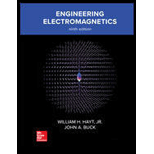
Concept explainers
(a)
The voltage
Answer to Problem 6.39P
The voltage
Explanation of Solution
Calculation:
The general solution of Laplace's equation is written as,
Here,
Substitute
Equation (2) is simplified as,
Substitute
Equation (4) is simplified as,
Subtracting equation (5) from equation (3) as,
By solving equation (6) the values of
Substitute
Conclusion:
Therefore, the voltage
(b)
The electric field
Answer to Problem 6.39P
The electric field intensity
Explanation of Solution
Calculation:
The electric field
Here,
Differentiate the equation (7) with respect to
Substitute
Conclusion:
Therefore, the electric field intensity
(c)
The electric field displacement
Answer to Problem 6.39P
The electric field displacement
Explanation of Solution
Calculation:
The electric field displacement
Here,
Substitute
Conclusion:
Therefore, the electric field displacement
(d)
The charge surface density
Answer to Problem 6.39P
The charge surface density is
Explanation of Solution
Calculation:
The charge surface density
Here,
Substitute
Conclusion:
Therefore, the charge surface density is
(e)
The charge
Answer to Problem 6.39P
The charge
Explanation of Solution
Calculation:
The charge
Here,
Substitute
Conclusion:
Therefore, the charge
(f)
The voltage
Answer to Problem 6.39P
The voltage
Explanation of Solution
Calculation:
The general solution of Laplace's equation is written as,
Substitute
Equation (13) is simplified as,
Substitute
Equation (15) is simplified as,
Subtracting equation (16) from equation (14) as,
By solving equation (17) the values of
Substitute
The electric field
Differentiate the equation (18) with respect to
Substitute
The electric field displacement
Substitute
The charge surface density
Substitute
The charge
Substitute
Conclusion:
Therefore, the voltage
(g)
The total charge on the lower plane and the capacitance between the planes.
(g)
Answer to Problem 6.39P
The total charge on the lower plane is
Explanation of Solution
Calculation:
The total charge
Here,
Substitute
The potential difference
Substitute
The capacitance
Substitute
Conclusion:
Therefore, the total charge on the lower plane is
Want to see more full solutions like this?
Chapter 6 Solutions
Engineering Electromagnetics
- 19. A life charge density of 24 nC/m is located in free space on the line y=1, z=2. (a) Find E at P(6,-1,3), (b) What point charge Q, should be located at Q(-34,1) to cause E, to be equal to zero at P?arrow_forwardSpherical surfaces at r = 1, 3, and 6 m carry uniform surface charge densities of 20 nC/m2, −4 nC/m2, and ρS0, respectively. Find D at r = 0.5, 2, 5, and 7 m.arrow_forwardA non-conducting, uniformly charged disc of surface charge density σ, radius Rand negligible thickness is rotating about its axis with an angular velocity ω. Consider a thin circular loop of radius dr at a distance r from the disk center as shown on the picture. Show that the charge on the thin loop is given bydq=2πσrdr.arrow_forward
- two conducting coaxial cylinders are located at rho =1 cm and rho = 1.5 cm. The inner conductor is maintained at 50 V while the outer one is grounded. If the cylinders are separated by a dielectric material with e = 4eo, find the surface charge density on the inner conductor.arrow_forwardVolume charge density is located in free space as ρν = 2e−100r nC/m3 for 0 < r < 3 mm, and ρν = 0 elsewhere. Find the total charge enclosed by the spherical surface r = 2 mm. By using Gauss’s law, calculate the value of Dr on the surface r = 2 mm.arrow_forwardGiven a coaxial capacitor with the length of L which has two coaxial conductors with radius a=1 cm and b= 4 cm for inner and outer conductor, respectively. The inner conductor carries the total charge of –Q C whilst the outer carries +Q C. If the length of the coaxial, L = 100m and the coaxial is filled with the lossy Teflon (εr = 2.2 and σ = 4 Sm-1), determine: i. Potential Different between r = 3cm and r = 6cm ii. Energy in region a<r<b Note: In dielectric material, permittivity ε=εoεr and D=εEarrow_forward
- Uniform line charges of 114 nC/m lie along the entire extent of the three coordinate axes. Assuming free space conditions, find Ez at P(-8, -1,4).arrow_forward6 The area to be considered in using Gauss's Law should be the one where the electric field is perpendicular. This surface is referred to as __________ . Select one: a. PLANE AREA SURFACE b. SPHERICAL SURFACE c. CYLINDRICAL SURFACE d. GAUSSIAN SURFACEarrow_forwardIf a line of charge with uniform density ρl extends between z=-L/2 and z=L/2 along the z-axis, obtain an expression for the electric field intensity at any point P(r, ϕ ,0) on the x-y plane. Investigate the case when L becomes infinite.arrow_forward
- In a medium characterized by σ = 0, µ = µ0, ε = 4ε0, and ?? = 20 sin((10^8) ? − ?z)?? V/m. Calculate k and H.arrow_forwardCompute for the work done, in millijoules, in moving a 2-nC charge from A(3, 0, -1) m to B(2, 4, -3) m against the electric field due to a disk charge of radius 4 m on the plane x = 0. The disk has a total charge of 9 mC.arrow_forwardA wedge-shaped surface has its corners located at (0, 0, 0), (2, 0, 4), and (2, 3, 4). If thesurface has charge distribution with ρs = 10x2yz mC/m2, find the total charge on thesurface.arrow_forward
 Introductory Circuit Analysis (13th Edition)Electrical EngineeringISBN:9780133923605Author:Robert L. BoylestadPublisher:PEARSON
Introductory Circuit Analysis (13th Edition)Electrical EngineeringISBN:9780133923605Author:Robert L. BoylestadPublisher:PEARSON Delmar's Standard Textbook Of ElectricityElectrical EngineeringISBN:9781337900348Author:Stephen L. HermanPublisher:Cengage Learning
Delmar's Standard Textbook Of ElectricityElectrical EngineeringISBN:9781337900348Author:Stephen L. HermanPublisher:Cengage Learning Programmable Logic ControllersElectrical EngineeringISBN:9780073373843Author:Frank D. PetruzellaPublisher:McGraw-Hill Education
Programmable Logic ControllersElectrical EngineeringISBN:9780073373843Author:Frank D. PetruzellaPublisher:McGraw-Hill Education Fundamentals of Electric CircuitsElectrical EngineeringISBN:9780078028229Author:Charles K Alexander, Matthew SadikuPublisher:McGraw-Hill Education
Fundamentals of Electric CircuitsElectrical EngineeringISBN:9780078028229Author:Charles K Alexander, Matthew SadikuPublisher:McGraw-Hill Education Electric Circuits. (11th Edition)Electrical EngineeringISBN:9780134746968Author:James W. Nilsson, Susan RiedelPublisher:PEARSON
Electric Circuits. (11th Edition)Electrical EngineeringISBN:9780134746968Author:James W. Nilsson, Susan RiedelPublisher:PEARSON Engineering ElectromagneticsElectrical EngineeringISBN:9780078028151Author:Hayt, William H. (william Hart), Jr, BUCK, John A.Publisher:Mcgraw-hill Education,
Engineering ElectromagneticsElectrical EngineeringISBN:9780078028151Author:Hayt, William H. (william Hart), Jr, BUCK, John A.Publisher:Mcgraw-hill Education,





